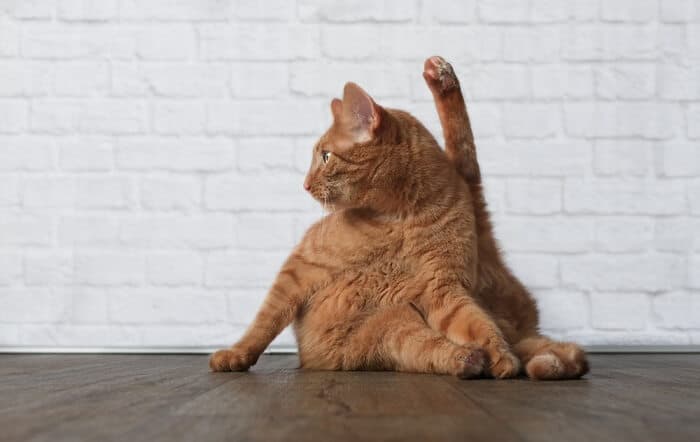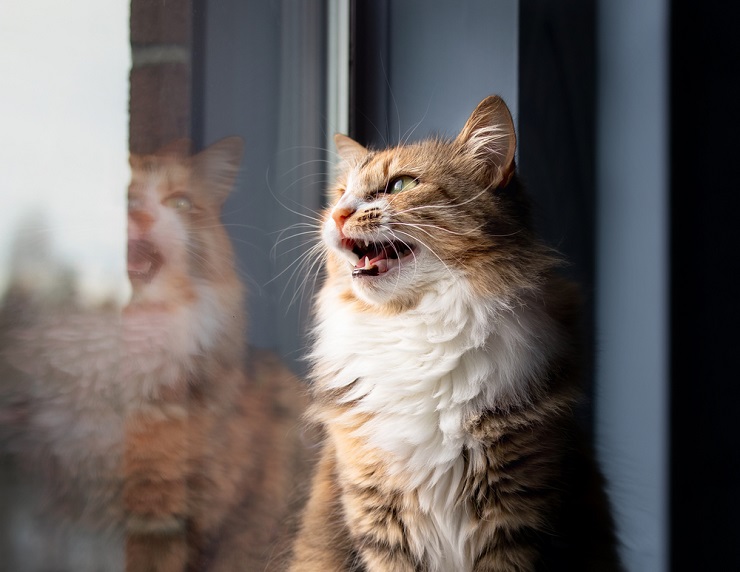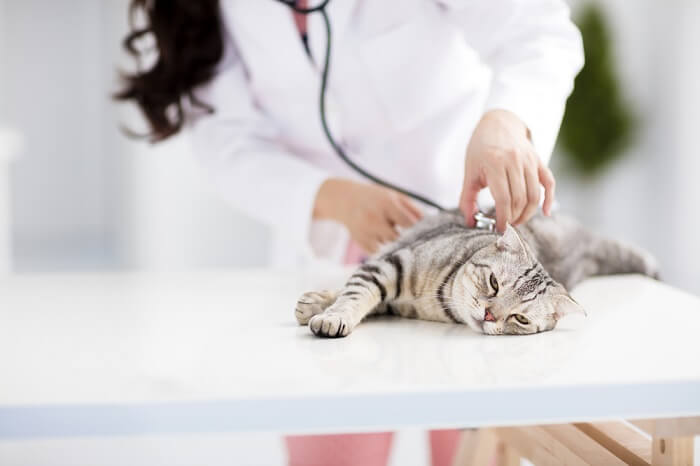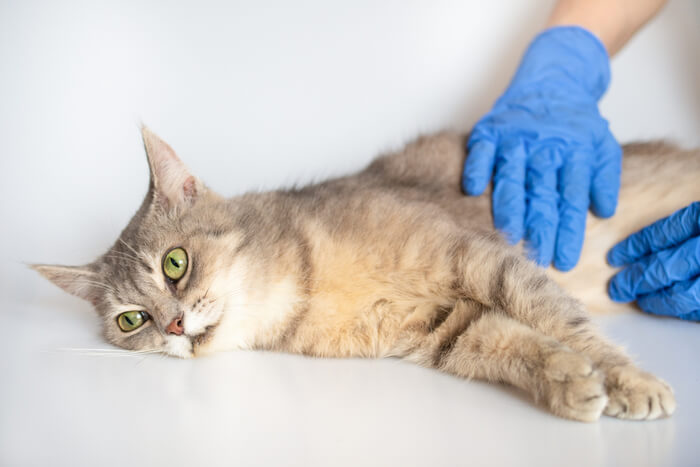
This article aims to explain the details of cat scooting, a behavior that can happen in cats for a number of reasons. The aim of this article is to provide a simple, clear explanation about cat scooting for cat owners.
What Is Cat Scooting?
Cat scooting describes the behavior when a cat rubs their rear end along the ground behind them. If you can imagine that a cat had a treacly, sticky substance applied under their tail, sticking to the skin around their anus, and the cat was trying to remove this by rubbing themselves along the ground, that’s what cat scooting looks like. Cats may do this in the litter box, on the kitchen floor, on a carpet, or outside.
How Common Is Cat Scooting?
This is a common problem, with a number of possible different causes. It is never “normal” for a cat to do this more than just occasionally, so if you care about your cat’s wellness, you should observe carefully to check that this does not happen more than e.g. once a week.
What Causes Cat Scooting?

Anything that causes a cat to feel itchiness or discomfort under their tail or around their anal area can cause a cat to start scooting.
Symptoms of Cat Scooting in Cats
The symptoms are obvious: the cat scoots along the ground, scraping along the ground using the area under the tail, around the anus and the upper back of the hind legs.
Causes of Cat Scooting
The most common causes include the following:
- Anal sac problems, including infections, impactions, and neoplasia of the anal glands
- Urinary tract issues, including Feline Lower Urinary Tract Disease (FLUTD), Feline Urologic Syndrome (FUS), and also, very rarely, the possibility of urinary tract obstruction. So-called urinary tenesmus (straining to pass urine) may present as scooting in some cases.
- Lower bowel or rectal issues that may cause difficulty with defecation, including colitis and constipation. So-called fecal tenesmus (straining to pass feces or poop) may present as scooting in some cases: if you see the scooting when the cat defecates, this type of cause may be suspected.
- Hormonal changes that affect a cat’s behavior may present as scooting e.g. a female cat in season
- Any conditions that cause itchy skin in the area under the tail may cause scooting
Possible causes of itchy skin in this area include:
- external parasite infestations such as fleas
- intestinal parasites such as some types of worms including tapeworms
- allergic or sensitive reactions to contact with a substance (allergen or irritant) in the environment (e.g. floor cleaners, carpets, dust mites etc)
- food allergies
- an abscess, e.g. following a cat bite in this area
Diagnosis of Cat Scooting

If you notice that your cat is scooting frequently, you may want to take them to a veterinarian to identify the issue’s underlying cause.
If you inform your DVM veterinarian that your cat is scooting, the following steps may be taken.
1. Detailed History Taking
Your vet will discuss every aspect of your cat’s life and health care, including checking for other medical issues. There are a number of possible causes of cat scooting, and this history will help to differentiate the various possible causes.
Your vet may ask you about issues like your cat’s behavior during pooping, the appearance of bowel movements, the general functioning of the digestive system, any weight loss you may have noticed, any other allergic reactions that may have happened in the past, and a range of other questions relating directly or indirectly to your cat’s scooting.
2. Physical Examination
Your veterinarian will check your cat over carefully, noting any physical signs of illness, and carefully inspecting the areas under the cat’s tail (including the cat’s anal glands) to check for possible causes of scooting.
In some cases, sedation may be needed to examine your cat in detail, as the under-the-tail area can be sensitive (especially if there are anal gland issues) and it can be difficult to examine a nervous, anxious, or aggressive cat. Your veterinarian may suggest the use of feline pheromones (e.g. feline friend) in the carrier to help keep your cat calm and relaxed prior to this examination.
3. Other Tests
Depending on what your veterinarian finds during the physical examination, they may wish to investigate the problem further. Possible tests that may be suggested include blood tests, urine tests, radiography (x-rays) and ultrasound.
Treatment for Cat Scooting
The treatment depends entirely on the underlying cause of the scooting. Home treatments are difficult to recommend, but it makes sense to treat for fleas, as well as deworming the cat with a broad spectrum dewormer. You may also wish to change cat food to rule out the possibility of the cause being food allergy.
How Much Does It Cost To Treat a Cat With Cat Scooting?

The cost of treating a cat who’s been scooting will depend on the underlying cause. Scooting caused by impacted anal sacs could be treated for under $100, while a more complicated condition could require treatment costing $1,000 or more.
It is impossible to estimate this cost, as there are so many possible reasons for this behavior. However a simple case (e.g. a cat with a impacted anal sacs) may cost less than $100 to treat, while a complex case (e.g. a tumor beside the anus) the final cost could be over $1000.
Monitoring and Prognosis
Pet owners can easily monitor their cats themselves, by observing carefully whether or not their cat continues to scoot after the treatment has been completed.
Cat scooting is a common sign that cats show if there is any cause of irritation under their tail, on the skin, or under the surface of the skin. In rarer cases, serious conditions such as constipation or urinary tract irritation or obstruction may also cause scooting. For this reason, the behavior should never be ignored, and if there is not an obvious minor cause, professional veterinary assistance should be sought.







